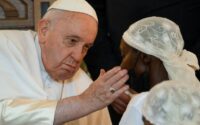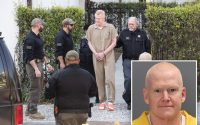Still no evidence of mass graves of indigenous children in Canada
After two years of horror stories about the alleged mass graves of indigenous children at residential schools across Canada, a series of recent excavations at suspected sites has turned up no human remains.
Some academics and politicians say it’s further evidence that the stories are unproven.
Minegoziibe Anishinabe, a group of indigenous people also known as Pine Creek First Nation, excavated 14 sites in the basement of Our Lady of Seven Sorrows Catholic Church near the Pine Creek Residential School in Manitoba during four weeks this summer.
The so-called “anomalies” were first detected using ground-penetrating radar but on Aug. 18, Chief Derek Nepinak of remote Pine Creek Indian Reserve said no remains were found.
He also referred to the effort as the “initial excavation,” leading some who were skeptical of the original claims to think even more are planned.
“I don’t like to use the word hoax because it’s too strong but there are also too many falsehoods circulating about this issue with no evidence,” Jacques Rouillard, a professor emeritus in the Department of History at the Université de Montréal, told The Post Wednesday.

Nonetheless, he welcomes more excavations because of the enormous adverse publicity and stain left on Canada after the first reports of the alleged mass graves.
“This has all been very dark for Canada. We need more excavations so we can know the truth,” Rouillard said. “Too much was said and decided upon before there was any proof.”
In May 2021, the leaders of the British Columbia First Nation Band Tk’emlúps te Secwépemc announced the discovery of a mass grave of more than 200 Indigenous children detected via ground-penetrating radar at a residential school in British Columbia. The radar found “anomalies” in the soil but no proof of actual human remains.
“We had a knowing in our community that we were able to verify. To our knowledge, these missing children are undocumented deaths,” Rosanne Casimir, chief of the Tk’emlúps te Secwépemc, said in a statement on May 27, 2021. (Casimir did not return a call from The Post this week.)

The band called the discovery “Le Estcwicwéy̓” — or “the missing.”
Pine Creek and Kamloops were among a network of residential schools across Canada, run by the government and operated by churches from the 1880s through the end of the 20th century. Experts say an estimated 150,000 children attended the schools.
But up until last week, there hadn’t been any excavations in the alleged burial spots. There still have been no excavations at Kamloops nor any dates set for any such work to commence.
That didn’t stop many in Canada from painting a demonic picture of the residential schools and those who staffed them.

“The system forcibly separated children from their families for extended periods of time and forbade them to acknowledge their Indigenous heritage and culture or to speak their own languages,” according to the website of the First Nations and Indigenous Studies of the University of British Columbia.
Assembly of First Nations (AFN) Grand Chief RoseAnne Archibald told the BBC in August 2021 that the residential school policy was “designed to kill, and we’re seeing proof of that … “
Within days of the Kamloops announcement, Prime Minister Justin Trudeau decreed, partly at the request of tribal leaders, that all flags on federal buildings fly at half-mast. The Canadian government and provincial authorities pledged about $320 million to fund more research and in December pledged another $40 billion involving First Nations child-welfare claim settlements that partially compensate some residential school attendees.

Pope Francis issued a formal apology on behalf of the Catholic church, which ran many of the residential school facilities, and asked for God’s forgiveness.
A number of writers, academics and politicians like Rouillard have come out cautioning against the claim that hundreds or thousands of children are buried at the school, but they have been labeled “genocide deniers” — even though many of the skeptics do not dispute that conditions at the schools were often harsh.
“The evidence does not support the overall gruesome narrative put forward around the world for several years, a narrative for which verifiable evidence has been scarce, or non-existent,” James C. McCrae, a former attorney general for Manitoba, wrote in an essay published last year.

McCrae resigned from his position on a government panel in May after his views on residential schools outraged Indigenous groups and other activists and politicians.
Tom Flanagan, a professor emeritus of political science at the University of Calgary, told The Post Wednesday that he sees the issue as a “moral panic” similar to the hysteria over repressed memories and alleged Satanic cults in schools in the US in the 1980s and 90s.
“People believe things that are not true or improbable and they continue to believe it even when no evidence turns up,” Flanagan said. “People seem to double down on their conviction that something happened.”

Eldon Yellowhorn, a professor and founding chair of the Indigenous Studies department at Simon Fraser University in British Columbia, told The Post last year that he was also cautious about the veracity of some of the more highly-charged claims.
Yellowhorn, a member of the Blackfoot Nation, had been hired by Canada’s powerful Truth and Reconciliation Commission to search for and identify grave sites of indigenous children at the residential schools. But he said then that many of the graves he found were from actual cemeteries and it wasn’t clear how they died.


